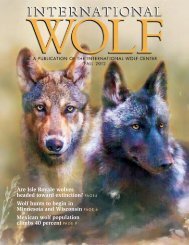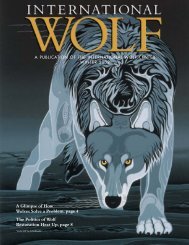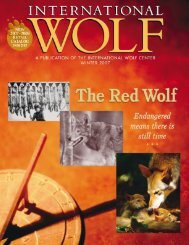a publication of the international wolf center spring 2007
a publication of the international wolf center spring 2007
a publication of the international wolf center spring 2007
Create successful ePaper yourself
Turn your PDF publications into a flip-book with our unique Google optimized e-Paper software.
Little Red’s Ongoing Story<br />
by Kevin Strauss<br />
You have all heard <strong>the</strong> Little Red<br />
Riding Hood story, right? But<br />
have you really? In your version,<br />
does Little Red trick <strong>the</strong> <strong>wolf</strong><br />
and escape? Does she get gobbled<br />
up with her granny?<br />
Folktales are stories that pass from<br />
one generation to ano<strong>the</strong>r and from<br />
one country to ano<strong>the</strong>r by word <strong>of</strong><br />
mouth. These stories may have changed<br />
over time as storytellers adapted<br />
<strong>the</strong>m for <strong>the</strong>ir own purposes. It<br />
wasn’t until <strong>the</strong> 1800s that folktales<br />
were written down for <strong>the</strong> first time,<br />
allowing hundreds <strong>of</strong> generations <strong>of</strong><br />
storytelling and story adapting to<br />
take place before that.<br />
You can <strong>of</strong>ten find several versions<br />
<strong>of</strong> <strong>the</strong> same story because <strong>the</strong>re is<br />
no one “right” version <strong>of</strong> a traditional<br />
folktale. Each one represents <strong>the</strong><br />
time, place and person telling it.<br />
Examining <strong>the</strong> cultural values<br />
expressed in a folktale will help you<br />
understand <strong>the</strong> story and its underlying<br />
messages better.<br />
The classic tale <strong>of</strong> Little Red Riding<br />
Hood is a good example <strong>of</strong> a story that<br />
reflects cultural values.<br />
Most versions <strong>of</strong> <strong>the</strong> story can be<br />
traced back to <strong>the</strong> 1600s to <strong>the</strong><br />
farming areas <strong>of</strong> central Europe. The<br />
people <strong>of</strong> that time and place possessed<br />
a general dislike for wolves<br />
due to <strong>the</strong> <strong>wolf</strong>’s predation on farm<br />
animals. So <strong>the</strong> <strong>wolf</strong> was universally<br />
considered a villainous character.<br />
The story also gives us insight into<br />
o<strong>the</strong>r cultural values such as <strong>the</strong> role<br />
<strong>of</strong> women and children in society.<br />
Some versions emphasize <strong>the</strong> vulnerability<br />
<strong>of</strong> little girls to moral perils<br />
in <strong>the</strong> world. O<strong>the</strong>rs demonstrate <strong>the</strong><br />
dangers <strong>of</strong> talking to shady characters.<br />
The oldest known versions <strong>of</strong><br />
<strong>the</strong> story stress <strong>the</strong> importance <strong>of</strong><br />
clever, resourceful thinking in getting<br />
a person out <strong>of</strong> a difficult situation.<br />
No matter which version <strong>of</strong> Little<br />
Red Riding Hood you find, be sure to<br />
look deeper than its face value, and<br />
consider <strong>the</strong> underlying cultural<br />
values expressed to get a full understanding<br />
<strong>of</strong> <strong>the</strong> story’s meaning. ■<br />
Kevin Strauss is a naturalist, author<br />
and storyteller from Ely, Minnesota.<br />
Visit <strong>the</strong> “Shop” section <strong>of</strong> www.<strong>wolf</strong>.org<br />
to purchase his book Song <strong>of</strong> <strong>the</strong> Wolf:<br />
Folktales and Legends from Around <strong>the</strong><br />
World, and audio CD The Mountain<br />
Wolf’s Gift: Wolf Tales from Around<br />
<strong>the</strong> World. Contact him at<br />
kevin@naturestory.com.<br />
Try this!<br />
Go to your library, and check out as<br />
many different versions <strong>of</strong> <strong>the</strong> Little<br />
Red Riding Hood story as you can<br />
find. Look for versions in children’s<br />
picture books as well as in folktale<br />
collections in <strong>the</strong> 398.2 section <strong>of</strong><br />
<strong>the</strong> library. Read through at least<br />
four different versions <strong>of</strong> <strong>the</strong> story,<br />
and discuss with a friend:<br />
How are <strong>the</strong> stories different?<br />
Describe one or two lessons that<br />
each version <strong>of</strong> <strong>the</strong> story teaches.<br />
Speculate about <strong>the</strong> time,<br />
place and person telling <strong>the</strong>se<br />
stories...what do you guess<br />
might be true?<br />
How does <strong>the</strong> artwork accompanying<br />
<strong>the</strong> story contribute<br />
to your impression <strong>of</strong> Red or<br />
<strong>the</strong> <strong>wolf</strong>?<br />
International Wolf Spring <strong>2007</strong> 23







